Sir John Monash, Personal Files Book 13, 1 June - 1 July 1916, Part 10
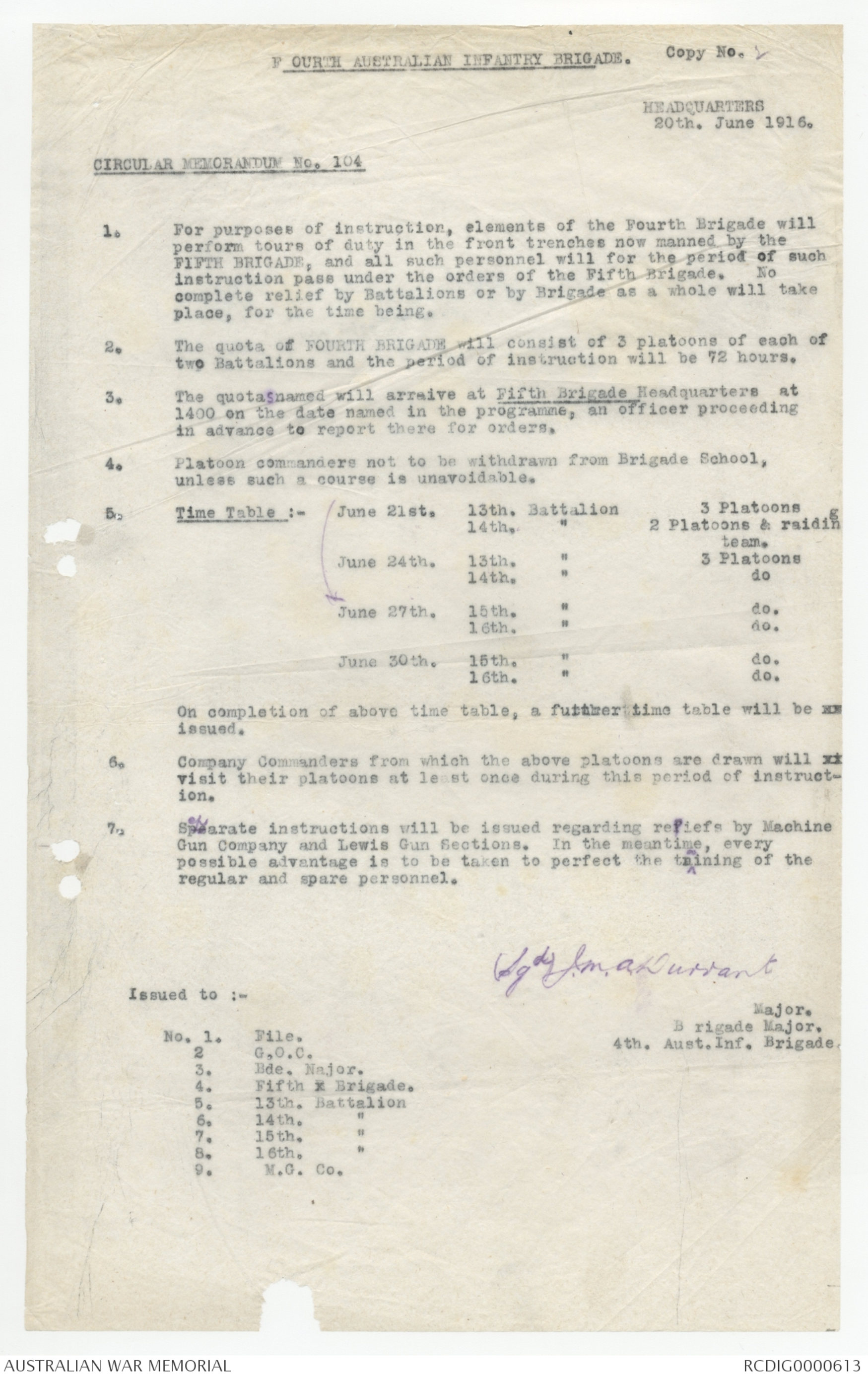
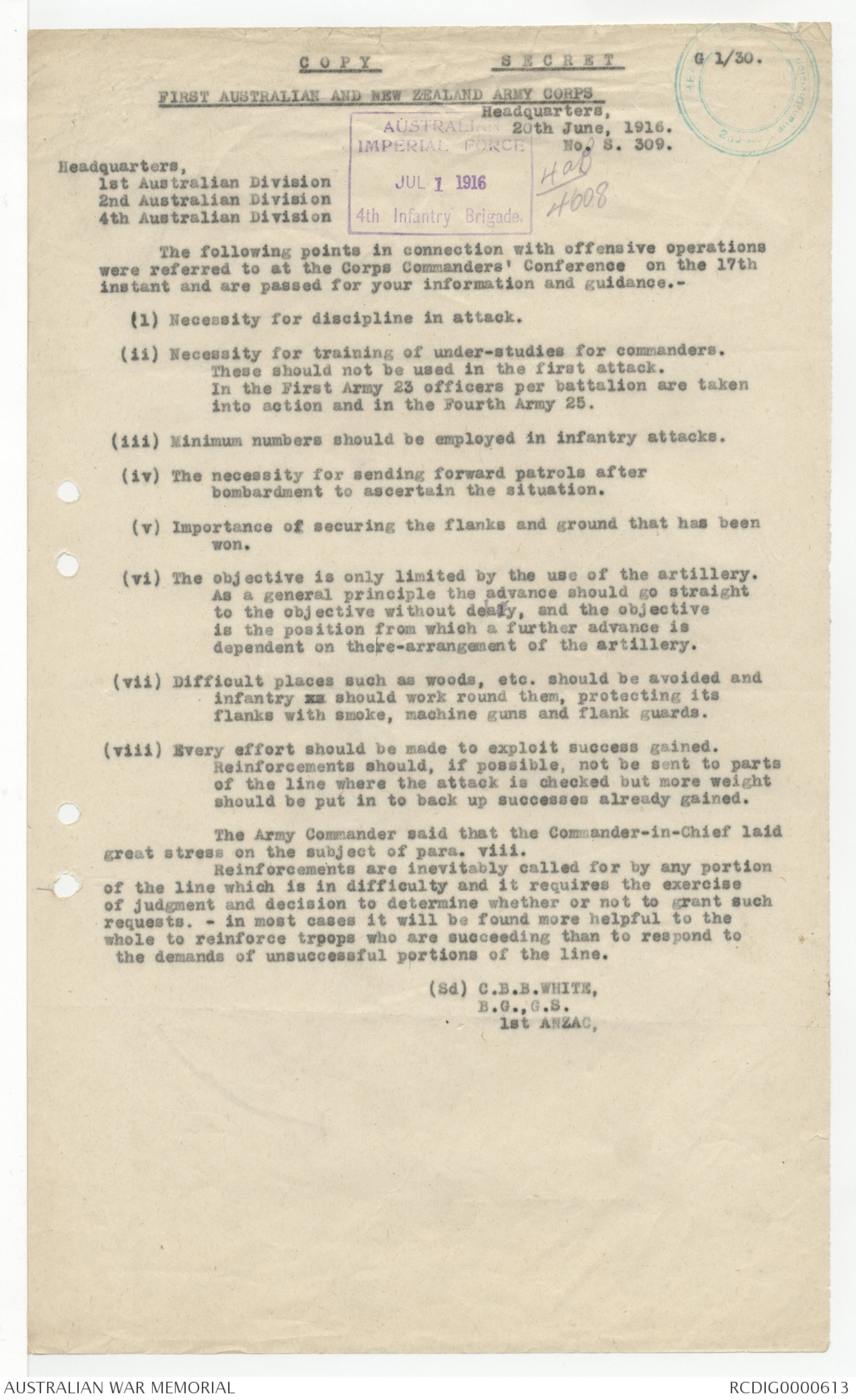
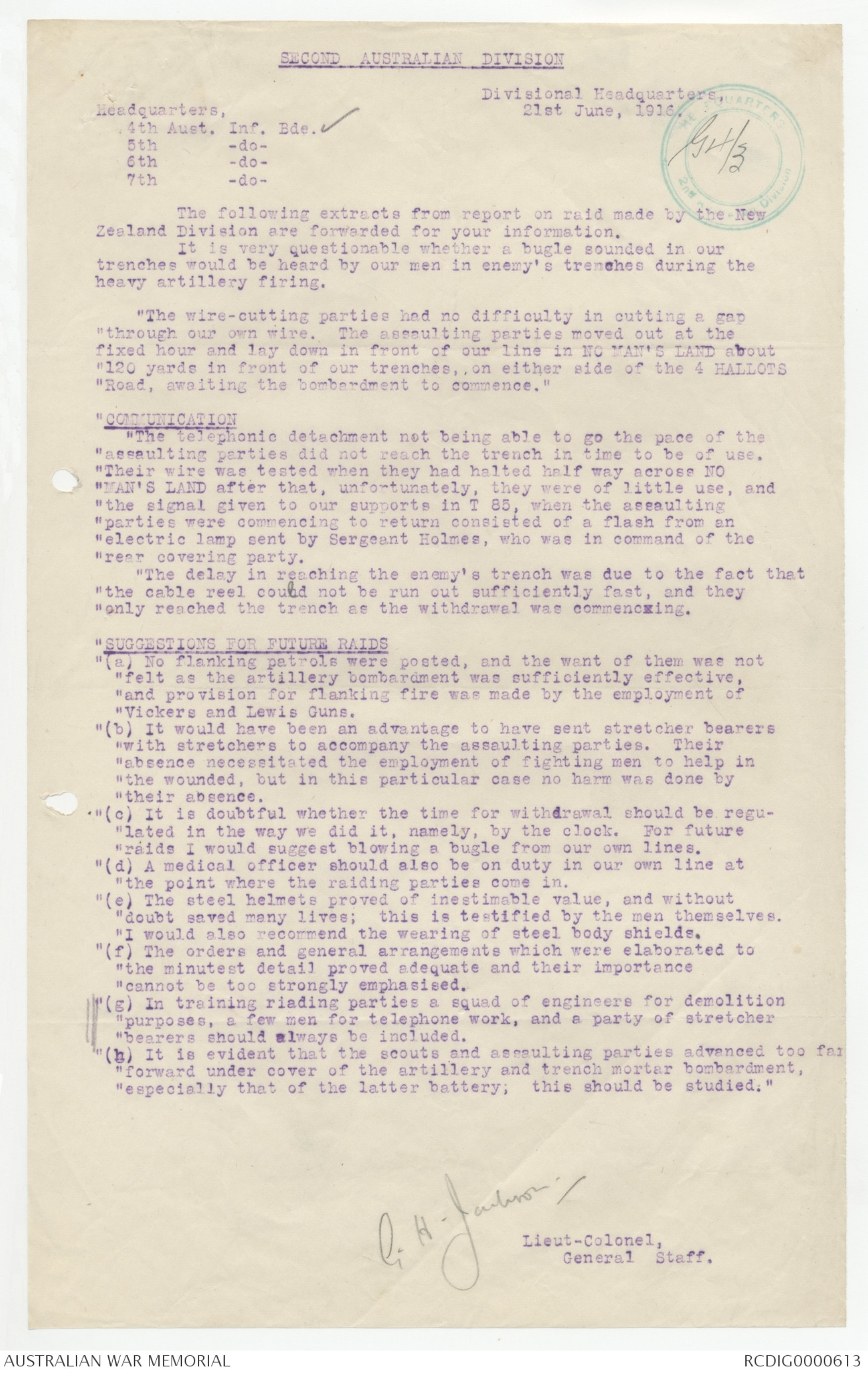
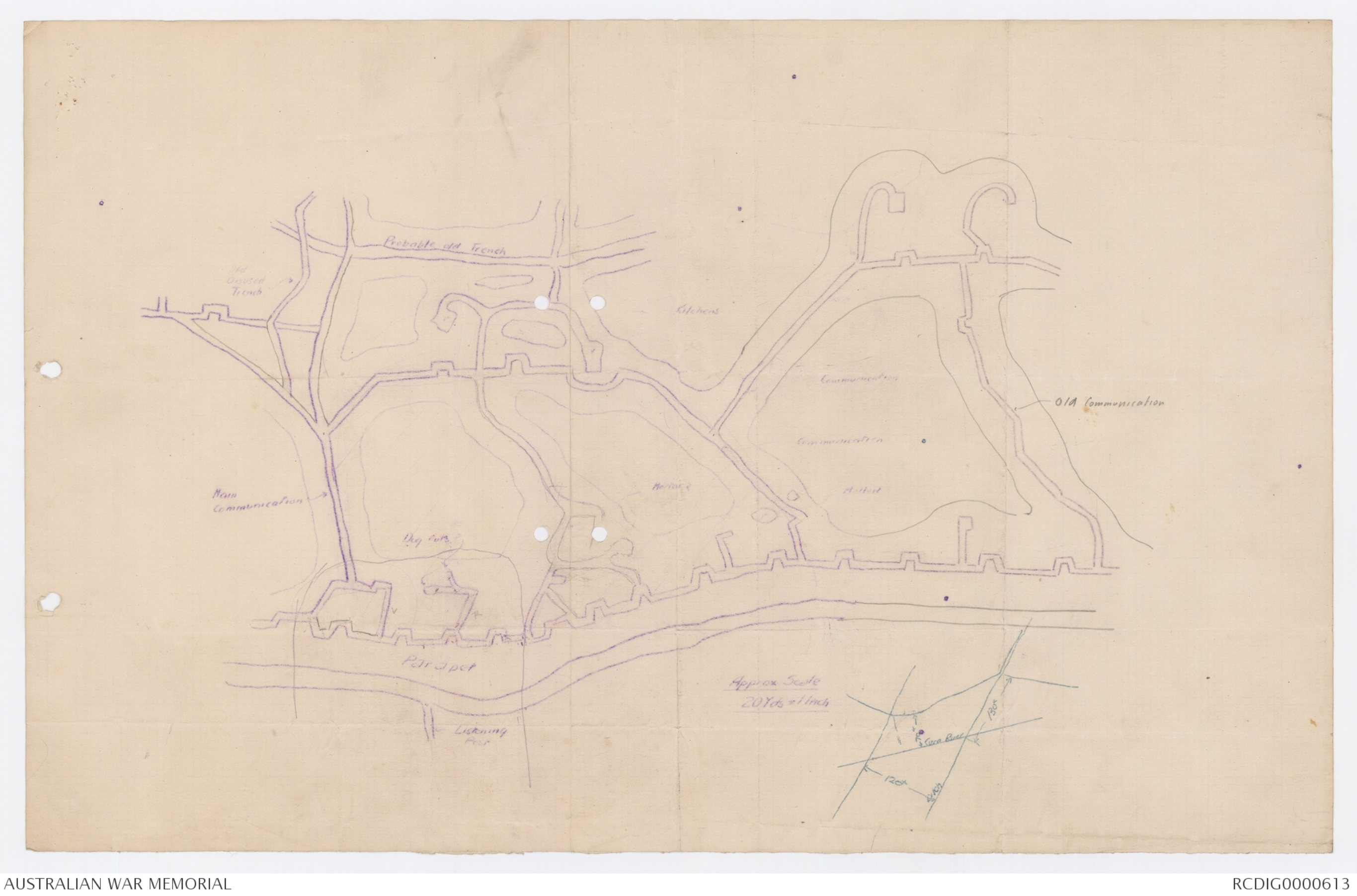
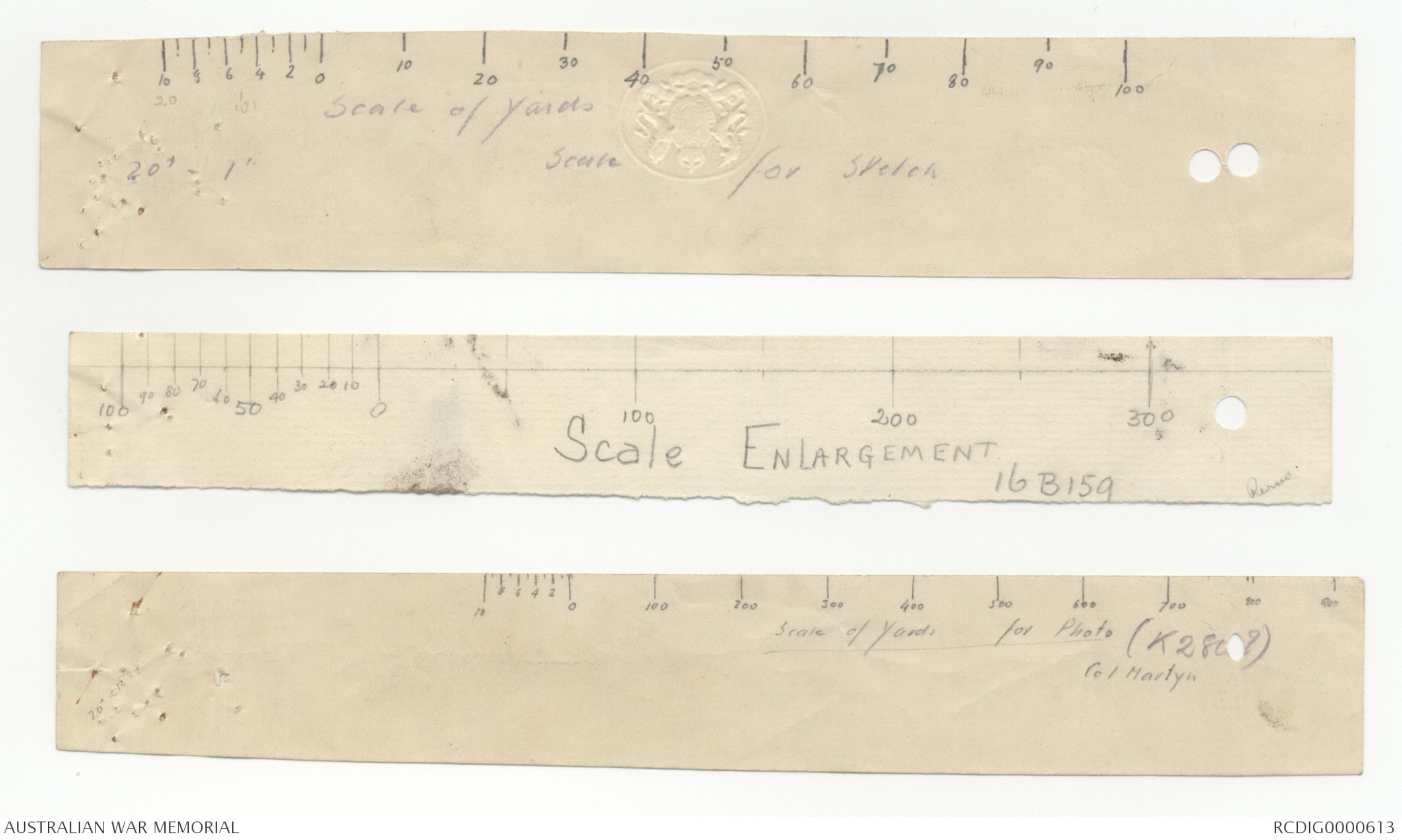
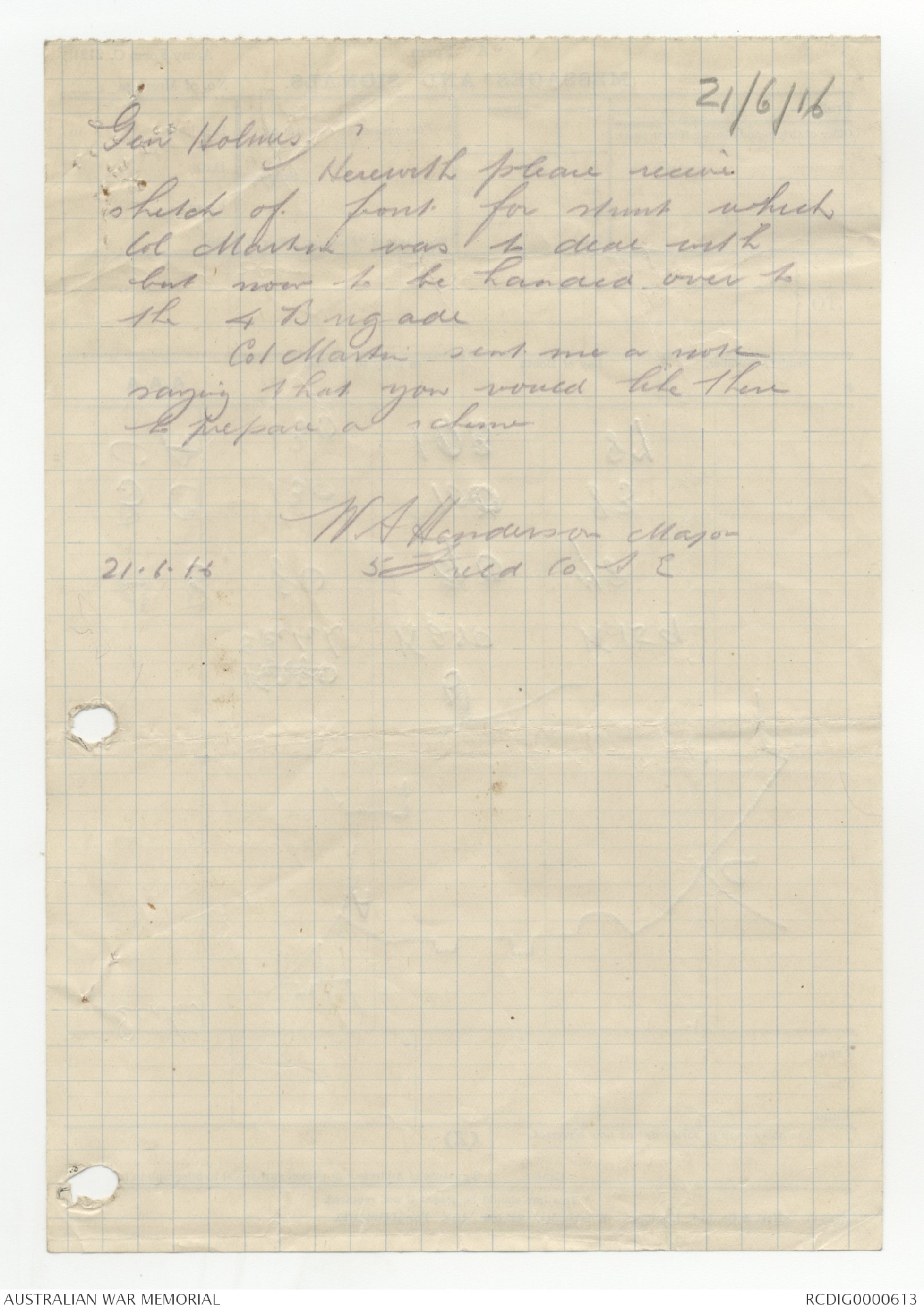
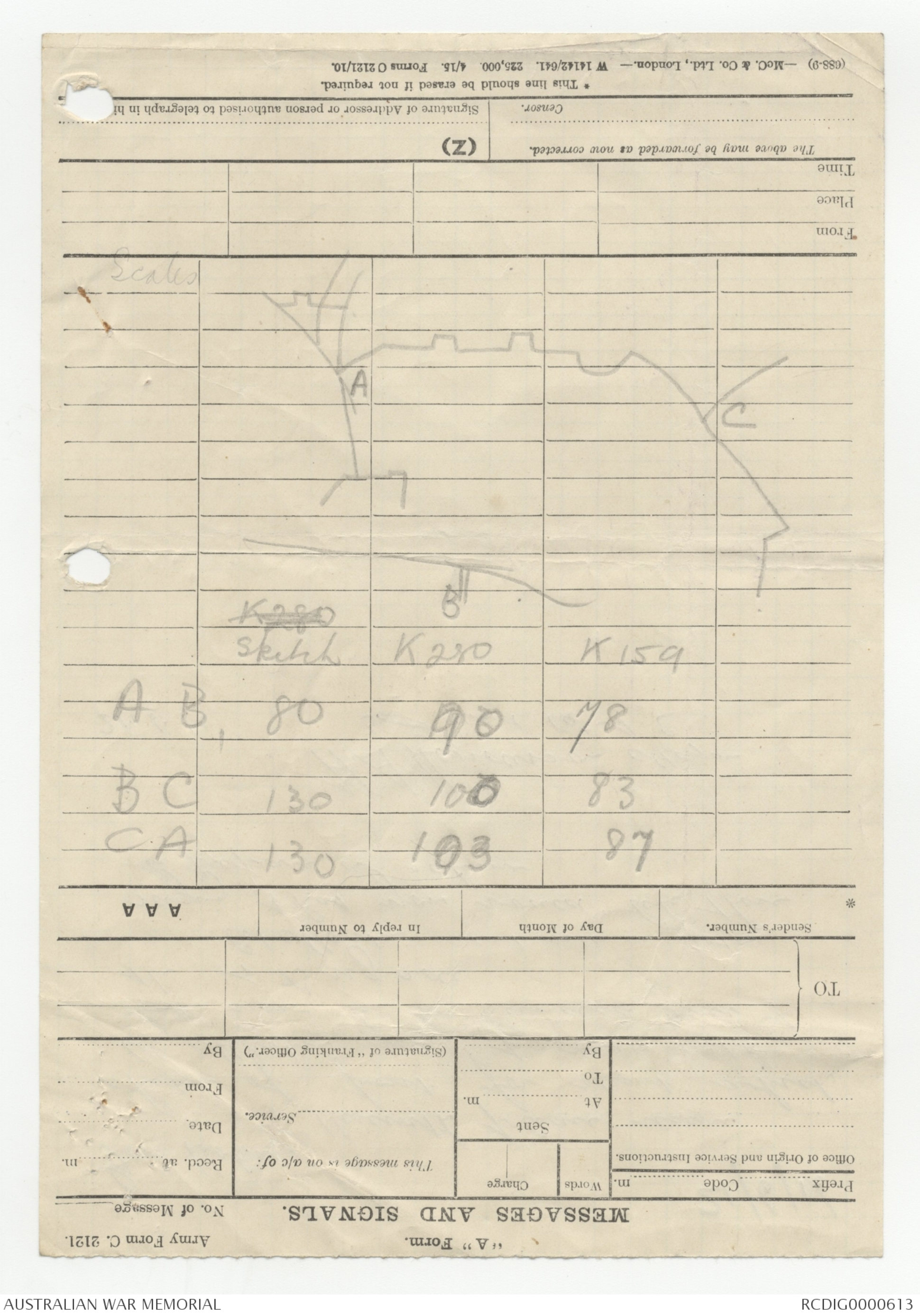
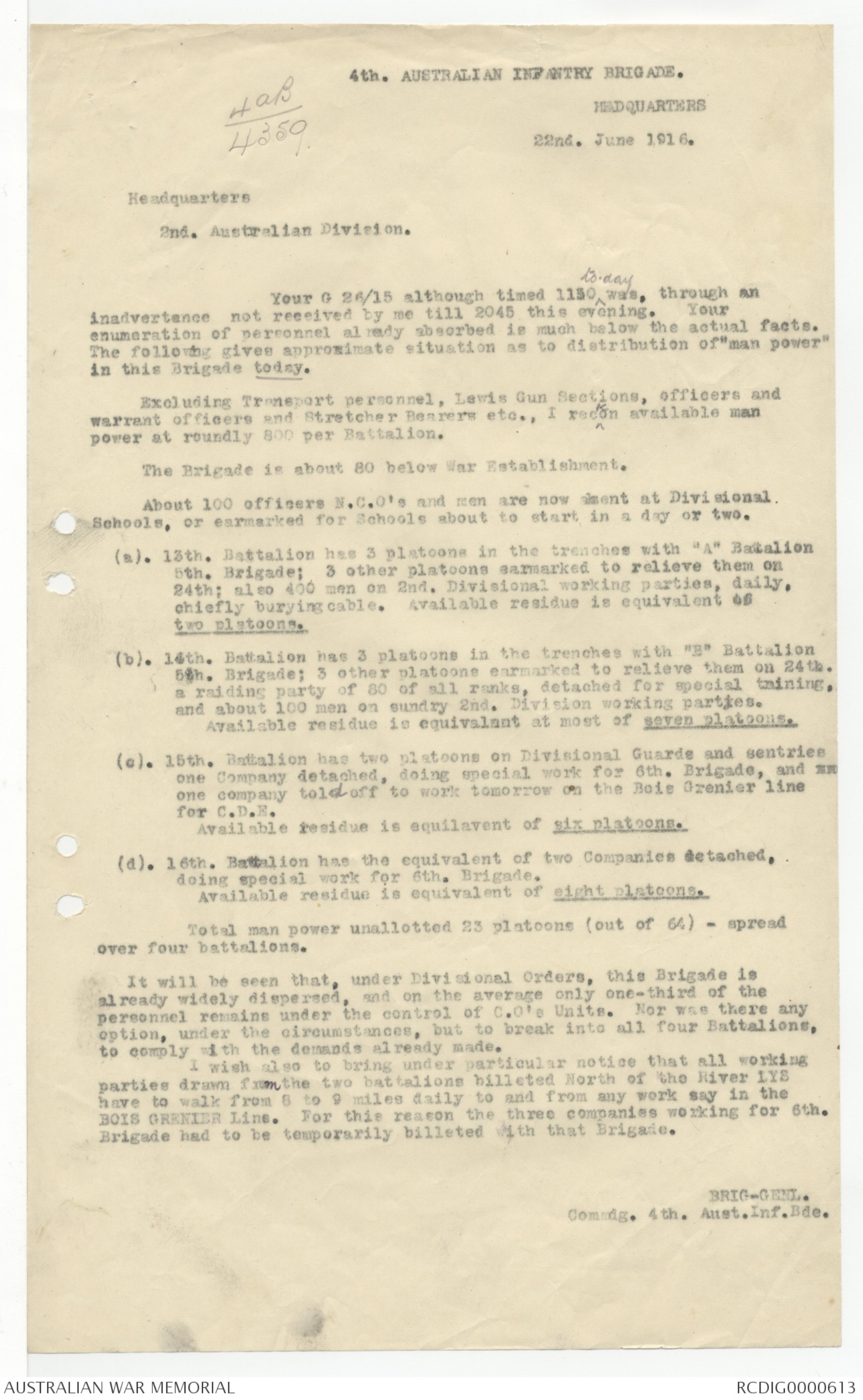
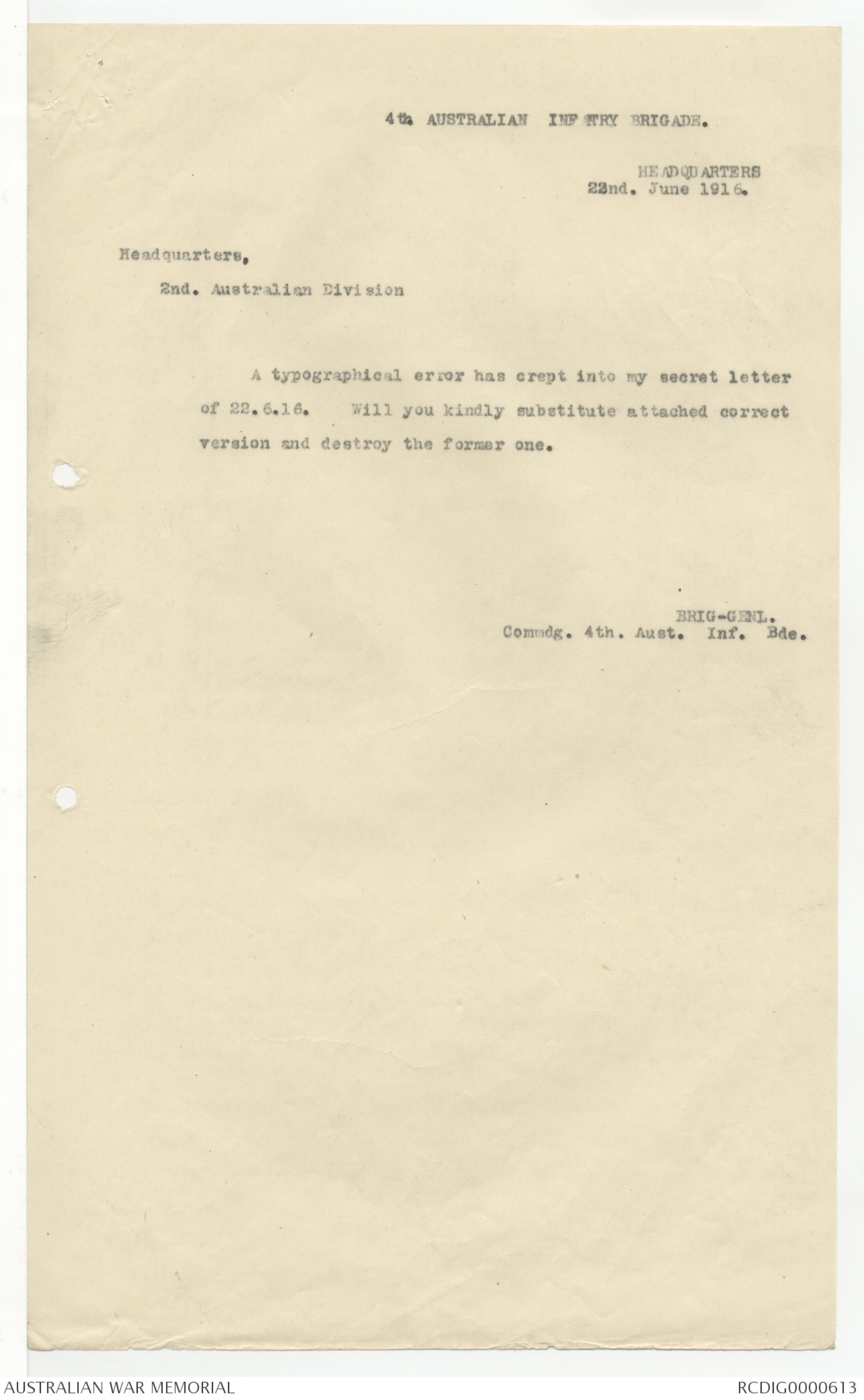
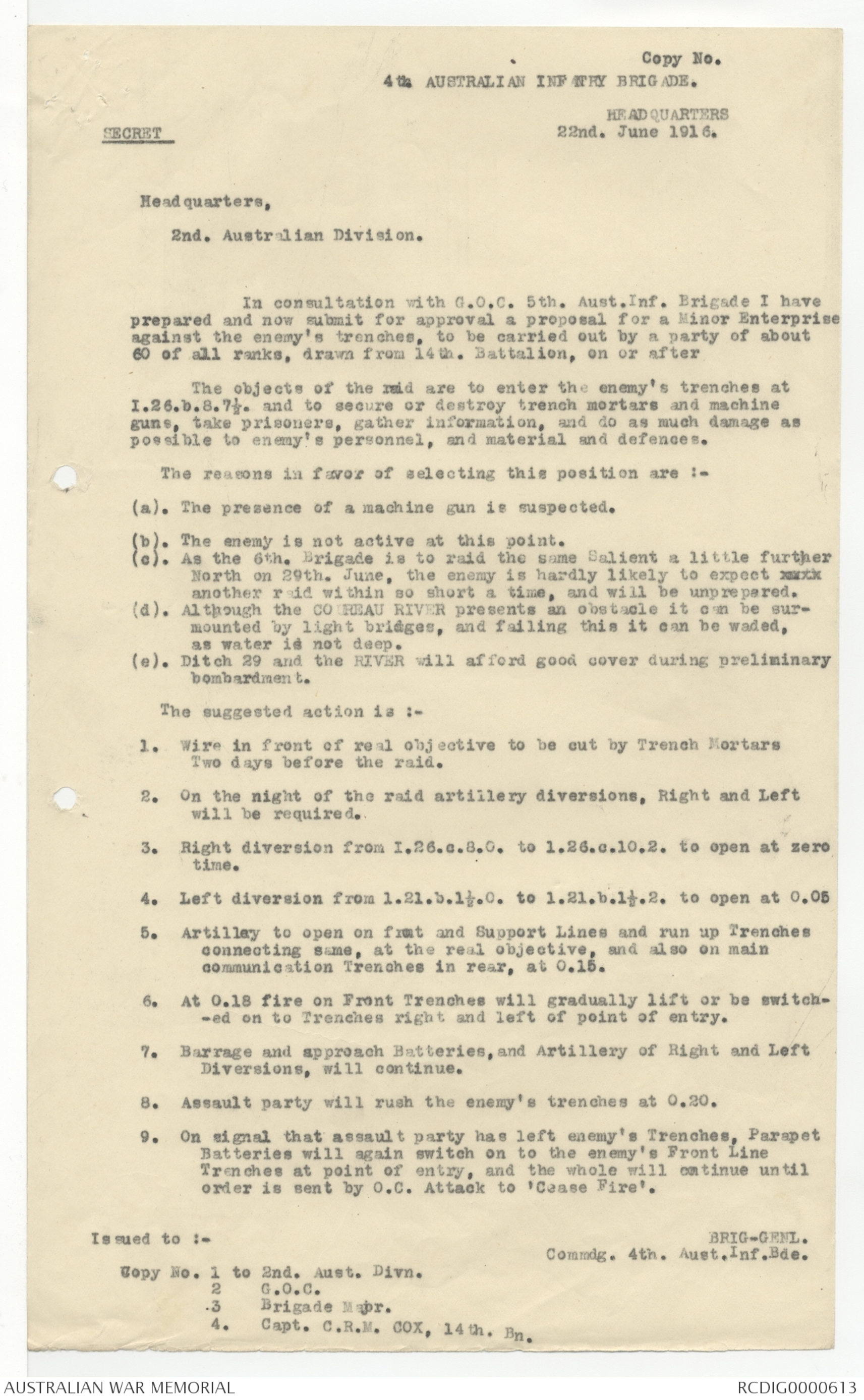
Copy No. 1
14th AUSTRALIAN INFANTRY BRIGADE.
HEADQUARTERS
20th. June 1916.
CIRCULAR MEMORANDUM No. 104
1. For purposes of instruction, elements of the Fourth Brigade will
perform tours of duty in the front trenches now manned by the
FIFTH BRIGADE, and all such personnel will for the period of such
instruction pass under the orders of the Fifth Brigade. No
complete relief by Battalions or by Brigade as a whole will take
place, for the time being.
2. The quota of FOURTH BRIGADE will consist of 3 platoons of each of
two Battalions and the period of instruction will be 72 hours.
3. The quotas named will arrive at Fifth Brigade Headquarters at
1400 on the date named in the programme, an officer proceeding
An advance to report there for orders.
4. Platoon commanders not to be withdrawn from Brigade School,
unless such a course is unavoidable.
5. Time Table:-
| June 21st. | 13th. Battalion | 3 Platoons |
| 14th. " | 2 Platoons & raiding team |
|
| June 24th. | 13th. " | 3 Platoons |
| 14th. " | do | |
| June 27th. | 15th. " | do |
| 16th. " | do | |
| June 30th. | 15th. " | do |
| 16th. " | do |
On completion of above time table, a further time table will be m
issued.
6. Company Commanders from which the above platoons are drawn will m
visit their platoons at least once during this period of instruction.
7. Separate instructions will be issued regarding reliefs by Machine
Gun Company and Lewis Gun Sections. In the meantime, every
possible advantage is to be taken to perfect the training of the
regular and spare personnel.
Sgd J.M.A. Durrant
Major.
Brigade Major.
4th. Aust. Inf. Brigade
Issued to:-
File.
No. 1. File
2. G.0.C.
3. Bde. Major.
4. Fifth Brigade.
5. 13th. Battalion
6. 14th. "
7. 15th. "
8. 16th. "
9. M.G. Co.
COPY
SECRET
FIRST AUSTRALIAN AND NEW ZEALAND ARMY CORPS
Headquarters,
20th June, 1916.
IMPERIAL FORCE
No. S. 308.
Headquarters,
4AB/4608
AUSTRALIAN
IMPERIAL FORCE
JUL 1 1916
4th Infantry Brigade.
Headquarters,
1st Australian Division
2nd Australian Division
4th Australian Division
The following points in connection with offensive operations
were referred to at the Corps Commanders’ Conference on the 17th
instant and are passed for your information and guidance.-
(i) Necessity for discipline in attack.
(ii) Necessity for training of under-studies for commanders.
These should not be used in the first attack.
In the First Army 23 officers per battalion are taken
into action and in the Fourth Army 25.
(iii) Minimum numbers should be employed in infantry attacks.
(iv) The necessity for sending forward patrols after
bombardment to ascertain the situation.
(v) Importance of securing the flanks and ground that has been
won.
(vi) the objective is only limited by the use of the artillery.
As a general principle the advance should be straight
to the objective without delay, and the objective
is the position from which a further advance is
dependent on there-arrangement of the artillery.
(vii) Difficult places such as woods, etc. should be avoided and
infantry an should work round them, protecting its
flanks with smoke, machine guns and flank guards.
(viii) Every effort should be made to exploit success gained.
Reinforcements should, if possible, not be sent to parts
of the line where the attack is checked but more weight
should be put in to back up successes already gained.
The Army Commander said that the Commander-in-chief laid
great stress on the subject of para. viii.
Reinforcements are inevitably called for by any portion
of the line which is in difficulty and it requires the exercise
of judgment and decision to determine whether or not to grant such
requests. - in most cases it will be found more helpful to the
whole to reinforce troops who are succeeding than to respond to
the demands of unsuccessful portions of the line.
(Sd) C.B.B.WHITE,
B.G.,G.S.
1st ANZAC,
SECOND AUSTRALIAN DIVISION
Divisional Headquarters,
21st June, 1916
HEADQUARTERS
G4/3
2nd [[?]] DIVISION
Headquarters,
4th Aust. Inf. Bde.√
5th -do-
6th -do-
7th -do-
The following extracts from report on raid made by the New
Zealand Division are forwarded for your information.
It is very questionable whether a bugle sounded in our
trenches would be heard by our men in enemy's trenches during the
heavy artillery firing.
"The wire-cutting parties had no difficulty in cutting a gap
"through our own wire. The assaulting parties moved out at the
fixed hour and lay down in front of our line in NO MAN'S LAND about
"120 yards in front of our trenches, on either side of the 4 HALLOTS
"Road, awaiting the bombardment to commence."
"COMMUNICATION
"The telephonic detachment not being able to go the pace of the
"assaulting parties did not reach the trench in time to be of use.
"Their wire was tested when they had halted half way across NO
"MANS LAND after that, unfortunately, they were of little use, and
"the signal given to our supports in T 85, when the assaulting
"parties were commencing to return consisted of a flash from an
"electric lamp sent by Sergeant Holmes, who was in command of the
"rear covering party.
"The delay in reaching the enemy's trench was due to the fact that
"the cable reel could not be run out sufficiently fast, and they
"only reached the trench as the withdrawal was commencing.
"SUGGESTIONS FOR FUTURE RAIDS
("a) No flanking patrols were posted, and the want of them was not
"felt as the artillery bombardment was sufficiently effective
"and provision for flanking fire was made by the employment of
"Vickers and Lewis Guns.
"(b) It would have been an advantage to have sent stretcher bearers
"with stretchers to accompany the assaulting parties. Their
"absence necessitated the employment of fighting men to help in
"the wounded, but in this particular case no harm was done by
"their absence.
"(c) It is doubtful whether the time for withdrawal should be regulated
"in the way we did it, namely, by the clock. For future
"raids I would suggest blowing a bugle from our own lines,
"(d) A medical officer should also be on duty in our own line at
"the point where the raiding parties come in.
"(e) The steel helmets proved of inestimable value, and without
"doubt saved many lives; this is testified by the men themselves.
"I would also recommend the wearing of steel body shields.
"(f) The orders and general arrangements which were elaborated to
"the minutest detail proved adequate and their importance
"cannot be too strongly emphasised.
"(g) In training raiding parties a squad of engineers for demolition
"purposes, a few men for telephone work, and a party of stretcher
"bearers should always be included.
"(h) it is evident that the scouts and assaulting parties advanced too fer
"forward under cover of the artillery and trench mortar bombardment,
"especially that of the latter battery; this should be studied."
G H Jackson
Lieut-Colonel
General Staff.
Diagram - see original document
Diagram - see original document
21/6/16
Gen Holmes
Herewith please receive
sketch of front for stunt which
Col Martin was to deal with
but now to be handed over to
the 4 Brigade
Col Martin sent me a note
saying that you would like these
to prepare a scheme
W A Henderson Major
5 Field Co. S E
21.6.16
Diagram - see original document
Sketch |
K280 | K159 | |
| A B, | 80 | 90 | 78 |
| B C | 130 | 100 | 83 |
| C A | 130 | 103 | 87 |
4AB/4350
4th. AUSTRALIAN INFANTRY BRIGADE.
HEADQUARTERS
22nd. June 1916.
Headquarters
2nd. Australian Division..
Your G 26/15 although timed 1130, ^today was, , through an
inadvertence not received by me till 2045 this evening. Your
enumeration of personnel already absorbed is much below the actual facts.
The following gives approximate situation as to distribution of "man power"
in this Brigade today.
Excluding Transport personnel, Lewis Gun Sections, officers and
warrant officers and Stretcher Bearers etc., I reckon available man
power at roundly 800 per Battalion.
The Brigade is about 80 below War Establishment.
About 100 officers N.C.O's and men are now absent at Divisional.
Schools, or earmarked for Schools about to start, in a day or two.
(a). 13th. Battalion has 3 platoons in the trenches with "A" Battalion
5th. Brigade; 3 other platoons earmarked to relieve them on
24th; also 400 men on 2nd. Divisional working parties, daily,
chiefly burying cable. Available residue is equivalent of
two platoons.
(b). 16th. Battalion has 3 platoons in the trenches with "B" Battalion
5th. Brigade; 3 other platoons earmarked to relieve them on 24th.
a raiding party of 80 of all ranks, detached for special training,
and about 100 men on sundry 2nd. Division working parties.
Available residue is equivalent at most of seven platoons.
(cl. 15th. Battalion has two platoons on Divisional Guards and sentries
one Company detached, doing special work for 6th. Brigade, and xxx
one company told off to work tomorrow on the Bois Grenier line
For C.D.E.
Available residue is equivalent of two Companies detached,
(d). 16th. Battalion has the equivalent of two Companies detached,
doing special work for 6th. Brigade.
Available residue is equivalent of eight platoons
Total man power unallotted 23 platoons (out of 64) - spread
over four battalions.
It will be seen that, under Divisional Orders, this Brigade is
already widely dispersed, and on the average only one-third of the
personnel remains under the control of C.O's Units. Nor was there any
option, under the circumstances, but to break into all four Battalions,
to comply of the demands already made.
I wish also to bring under particular notice that all working
parties drawn from the two battalions billeted North of the River LYS
have to walk from 8 to 9 miles daily to and from any work say in the
BOIS GRENIER Line. For this reason the three companies working for 6th.
Brigade had to be temporarily billeted with that Brigade.
BRIG-GENL.
Commdg. 4th. Aust.Inf.Bde.
4th AUSTRALIAN INFANTRY BRIGADE.
HEADQUARTERS
22nd. June 1916.
Headquarters,
2nd. Australian Division
A typographical error has crept into my secret letter
of 22.6-16. Will you kindly substitute attached correct
version and destroy the former one.
BRIG-GENL.
Commdg. 4th. Aust. Inf. Bde.
Copy No.
4th. AUSTRALIAN INFANTRY BRIGADE.
HEADQUARTERS
22nd. June 1916.
SECRET
Headquarters
2nd. Australian Division.
In consultation with G.O.C. 5th. Aust. Inf. Brigade I have
prepared and now submit for approval a proposal for a Minor Enterprise
against the enemy’s trenches, to be carried out by a party of about
60 of all ranks, drawn from 14th. Battalion, on or after
The objects of the raid are to enter the enemy's trenches at
1.26.b.8. 7½. and to secure or destroy trench mortars and machine
guns, take prisoners, gather information, and do as much damage as
possible to enemy’s personnel, and material and defences.
The reasons in favor of selecting this position are :-
(a). The presence of a machine gun is suspected.
(b). The enemy is not active at this point.
(e). As the 6th. Brigade is to raid the same Salient a little further
North on 29th. June, the enemy is hardly likely to expect xxx
another raid within so short a time, and will be unprepared.
(d). Although the COUREAU RIVER presents an obstacle it can be
surmounted by light bridges, and failing this it can be waded,
as water is not deep.
(e). Ditch 29 and the RIVER will afford good cover during preliminary
bombardment.
The suggested action is :-
1. Wire in front of real objective to be cut by Trench Mortars
Two days before the raid.
2. On the night of the raid artillery diversions, Right and Left
will be required.
3. Right diversion from I.26.c.8.0. to 1.26.c.10.2. to open at zero
time.
4. Left diversion from 1.21.b.1½.0. to 1.21.b.1½.2. to open at 0.05
5. Artillery to open on front and Support Lines and run up Trenches
connecting same, at the real objective, and also on main
communication Trenches in rear, at 0.15.
6. At 0.18 fire on Front Trenches will gradually 11ft or be switched
on to Trenches right and left of point of entry.
7. Barrage and approach Batteries, and Artillery of Right and Left
Diversions, will continue.
8. Assault party will rush the enemy's trenches at 0.20.
9. On signal that assault party has left enemy's Trenches, Parapet
Batteries will again switch on to the enemy’s Front Line
Trenches at point of entry, and the whole will continue until
order is sent by O.C. Attack to "Cease Fire'.
BRIG-GENL.
Commdg. 4th. Aust, Inf.Bde.
Issued to :-
Copy No. 1 to 2nd. Aust. Divn.
2 G.O.C.
3 Brigade Major.
4 Capt. C.R.M. COX, 14th Bn.
 Maralyn K
Maralyn KThis transcription item is now locked to you for editing. To release the lock either Save your changes or Cancel.
This lock will be automatically released after 60 minutes of inactivity.